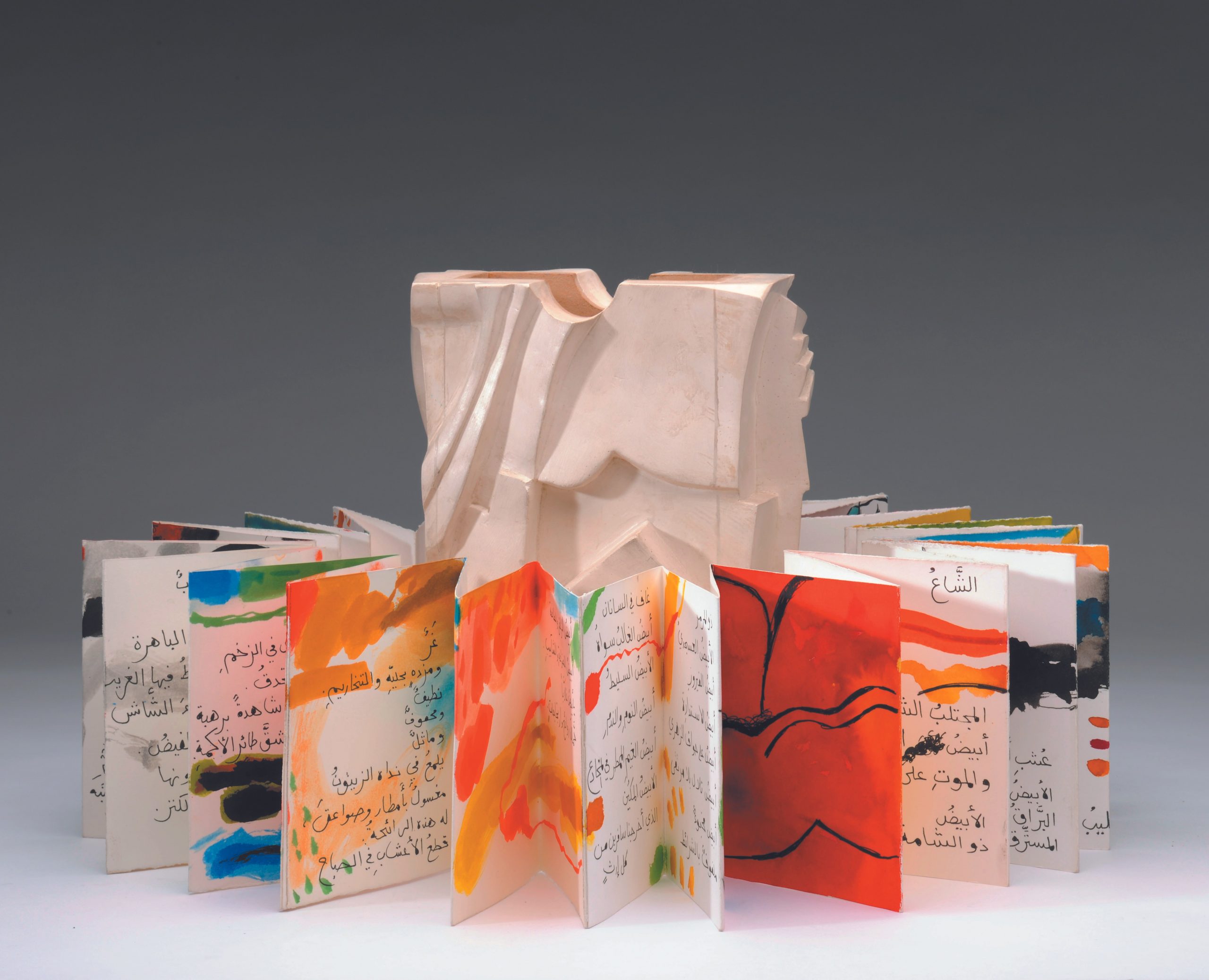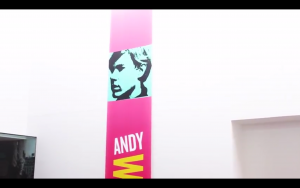
Painting Poetry: Dia al-Azzawi at the Ashmolean
by Eva Stuart | March 4, 2023
Dia al-Azzawi’s notebooks do not seem to contain notes. This is my immediate perception upon entering the intimate gallery, tucked inside the Ashmolean. I am met not with precise script in neat folios, but instead with inked pages, some reaching across entire walls, others bound into rippling concertinas. Across one blue wall, colour swims among the pinned-up pages; beside it stretches an enormous monochromatic canvas, the colour startlingly drained. What emerges is a combination of gestural washes and controlled lines – yet, upon further inspection, these are undoubtedly notes. They document Azzawi’s visceral response to years of conflict and loss in his native Iraq. Though not in an immediately legible form, pain permeates his work. It writhes within lines and howls through hollow charcoal eyes. The pages synthesise images and characters, and whilst they are rooted in pre-Islamic and Islamic manuscripts, as well as the ‘artists’ books’ tradition of painters like Matisse, they possess a unique script.
Azzawi began creating art that unites text and imagery in 1968, as the exhibition’s curator, Dr Francesa Leoni, tells me while guiding me around the gallery. He would adopt folio-like structures later on, but therein lies the undeveloped form of his genre, which he calls dafatir – Arabic for ‘notebooks’. Textual and pictorial language coalesce upon these pages, operating in a neat symbiosis to offer the viewer a layered presentation of poetry. Azzawi developed a particular method of production, listening to the poetry read aloud while he worked away at his pages. The visuals do not precisely depict sections of text; rather, they are emotive and holistic responses to the poems. The words are inscribed subsequently, an interesting inversion of typical illustration practices. Words and images are wholly equal, interacting with one another in a distinctive lyricism.
This may be an artistic novelty, but it is supported by heritage nonetheless. Motifs drawn from ancient Mesopotamian folklore and Islamic tradition can be picked out in the crescents and the eight-pointed stars. This investigation of cultural inheritance, an impulse we recognise in the present day, seems to seek to establish a relevant artistic language. Dr Leoni informs me that Azzawi co-authored the manifesto for the Iraqi ‘New Vision’ group in 1969, an artistic movement urging innovation in approaches to heritage. A video on one wall introduces Azzawi in miniature projected form, and he urges the room to “remember our art in the lands of Mesopotamia, Syria and the Nile”. Azzawi’s heritage offered him conceptual archetypes to explore his experiences, which are clear in his illustration of the Epic of Gilgamesh. I also notice some Assyrian and Sumerian sculptures nearby, with cavernous eye holes where the stone has been gouged away. This inherited imagery translates into Azzawi’s own work. A mother stands before the rigid corpse of her son: her eyes – gaping, dark, massive – are wrenchingly eloquent. The loss, not only of the human and urban fabric but also the cultural fabric of Iraq as a consequence of war, is palpable.
The effect of the war in Iraq on his daftar genre is striking. Following his move to London in 1983, Azzawi’s focus moved to images, discarding poetry to articulate his personal reactions. This initially still included text: an early concertina is a frantic blend of the two, a distinct departure from the meticulous screen prints and calligraphy of his earlier explorations. Images sprawl and text scrawls in an alarming mass of black ink. The colour is wholly drained. It seems to parallel the loss of life, the erosion of local civil societies and the shattering of cultural heritage. A later work documents his reactions to the start of the Gulf War (1990) and the coalition launch of Operation Desert Storm (1991): it is devoid of text, the pages consumed by sweeping charcoal. Monochromic facial features emphasise allusive spatters of red paint, with cavernous black eyes.
A tapestry, made starkly monochromatic beside a wall drenched in colour, reaches across the central wall. It stamps the most enduring memory of the exhibition. Created from a 2017 drawing, the piece is a reaction to the recapture of the city of Mosul from the so-called Islamic State. The quality of the inkwork is not lost in the weaving process, but the lines nonetheless frantically overlap, depicting images that almost seem to wrestle with one another. Mosul’s architecture – much of which destroyed following the Islamic State’s capture of the city in 2014 – is visible. When considering Azzawi’s own training as an archaeologist, its inclusion is even more tragic. The famously unbalanced ‘hunchback minaret’ of the Great Mosque of al-Nuri, blown up in June 2017, is not merely askew: it tilts violently across the centre of the composition. Fragments of monuments, such as the chariots of the old Assyrian reliefs, litter the scene. Heads with tightly knotted blindfolds are drawn into the background, whilst a faceless mother clutches what is presumably her child. The piece is the most visceral illustration of the artist’s pain.
Dia al-Azzawi’s work, and particularly his dafatir, are remarkable documentations of conflict. The sense of heritage and the corresponding pain at the destruction of this cultural fabric permeate his notebooks. The daftar is a dynamic genre. The exhibition dismisses the presumption that these notebooks contain no notes. Instead, they possess their own evocative vocabulary: textual and pictorial language meet upon a page in writhing confluence. The hollow eyes do speak. ∎
Dia al-Azzawi: Painting Poetry is on at the Ashmolean Museum until 11th June 2023. With thanks to Dr Francesca Leoni for the tour, given to the Edgar Wind Society.
Words by Eva Stuart.




